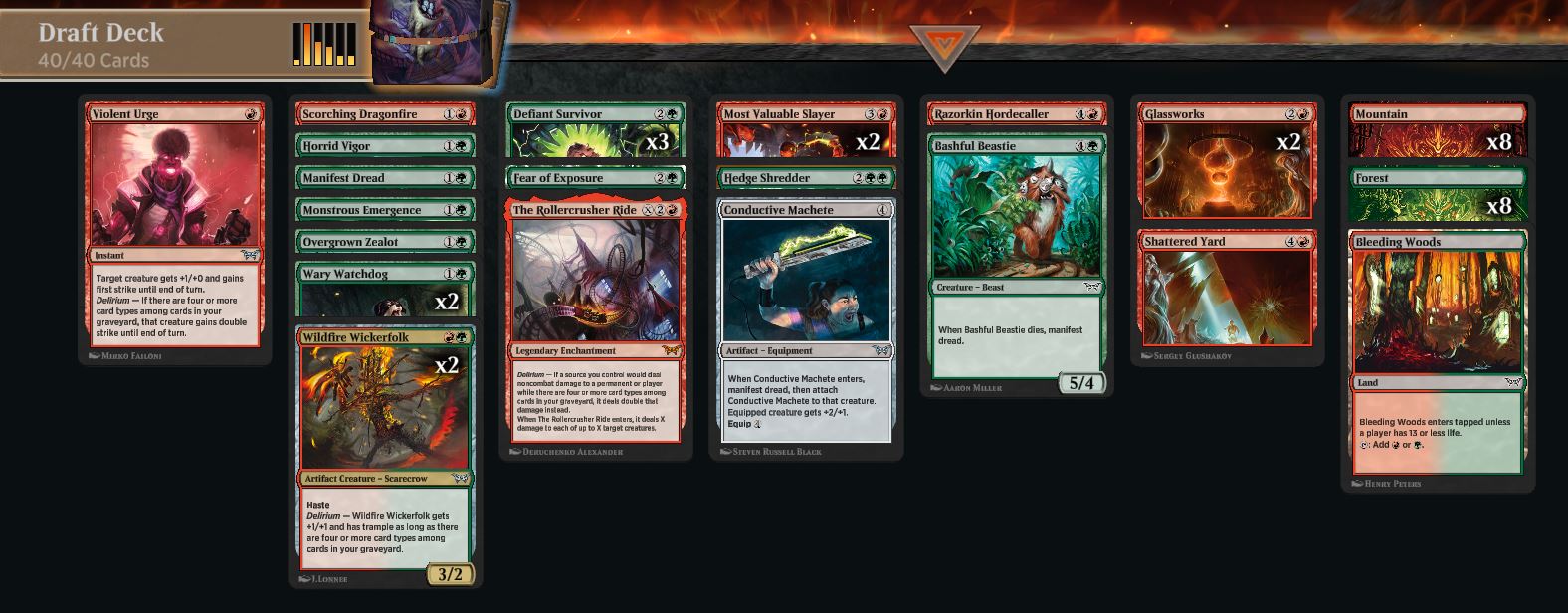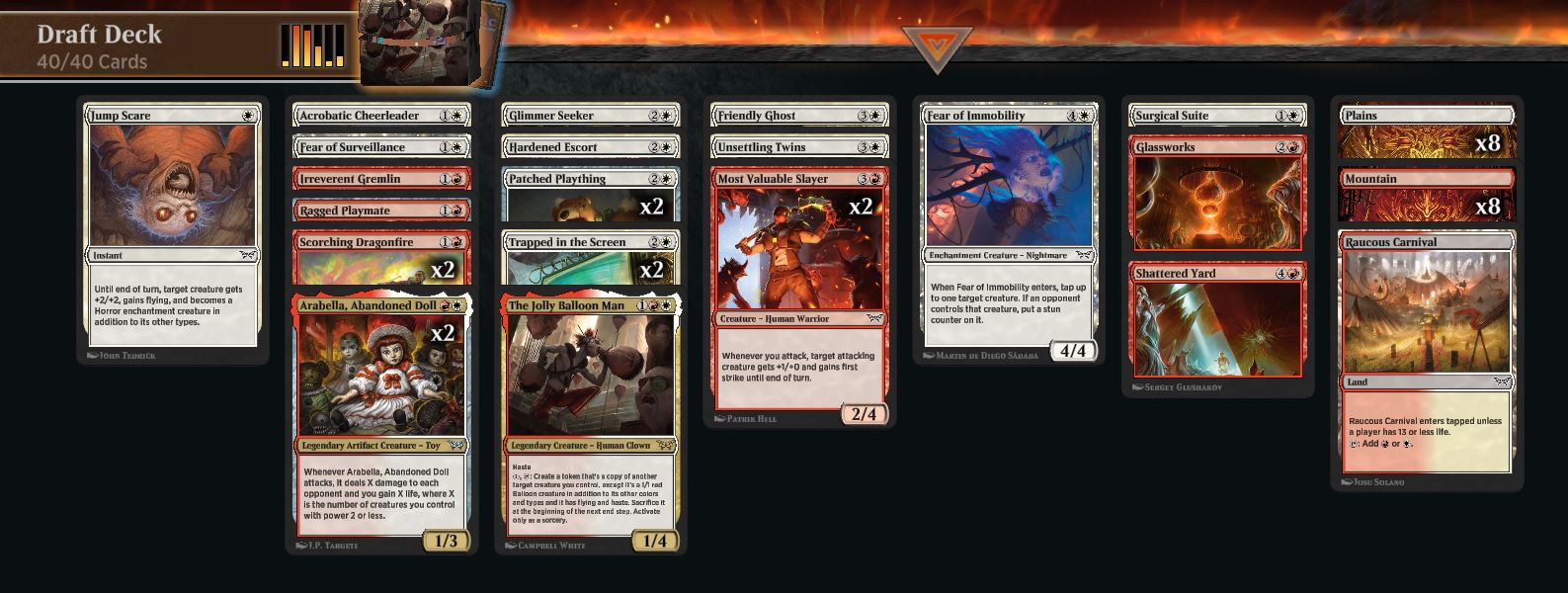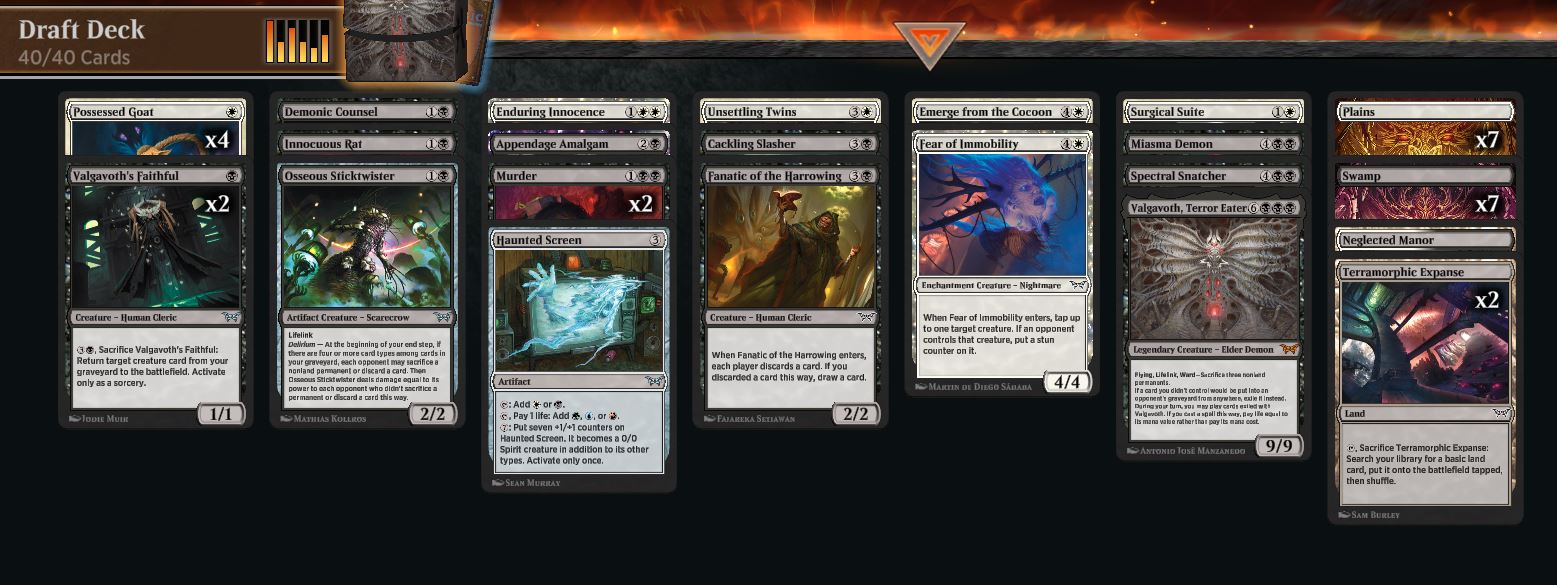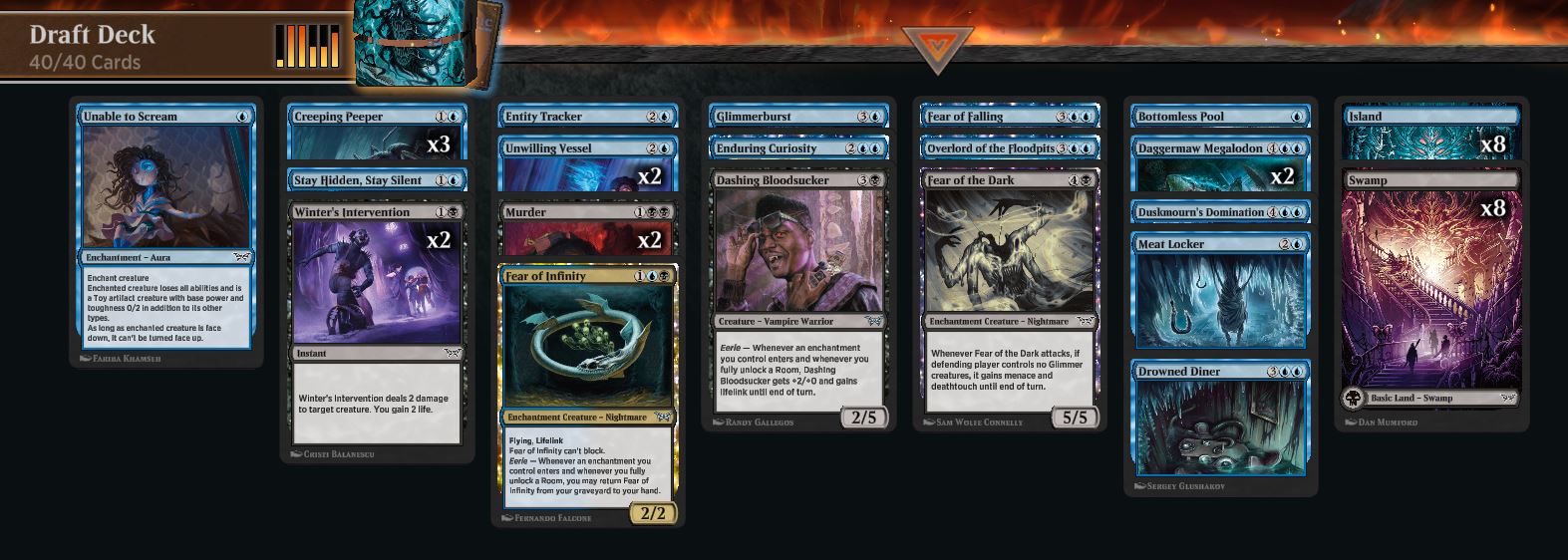Il tuo account
Loading...
Products
Magic: The Gathering Line
This Wednesday I was invited to the Early Access streamer event by Wizards of the Coast, which allowed me to get a bunch of Duskmourn drafts in.
Today I want to share with you what are my first impressions of the new limited environment, so you are better prepared for the prerelease or your first draft.
First thing you should always do these days is check the archetypes. Each of the 10 color pairs has a slightly different strategy and it is important to know what exactly that strategy is, so you can correctly evaluate which cards are a good fit for them and which cards to prioritize during the draft and deck building.
White/Blue: Eerie Aggro
"Eerie" is a new ability word that triggers whenever an enchantment you control enters or you fully unlock a Room card.
Blue/Black: Eerie Midrange/Control
Slower version of a deck built mostly around enchantment synergies and enter the battlefield effects.
Black/Red: Sacrifice
Get value from some sacrifice synergies.
Red/Green: Delirium Aggro
Focus on Delirium by adding artifacts and enchantments in your deck to get more value from your cards.
Green/White: Survival
Survival is a new mechanic which rewards you for having a tapped creature at the beginning of your second main phase. This means you want to focus on tricks to help your creatures survive combat or find other ways to tap them, for example with Vehicles.
White/Black: Reanimator
Get a big creature in your graveyard and reanimate it onto the battlefield.
Blue/Red: Rooms
Room is a new mechanic that is very similar to adventures. You can choose which side of the Room you unlock (play) first and then you can unlock the other one later.
Black/Green: Delirium midrange
Delirium is making a comeback and as usual, Golgari is the best color combination to take full advantage of having 4 or more different card types in the graveyard.
Red/White: Aggro with a focus on creatures with power 2 or less
This is the easiest deck to draft without prior knowledge of the format as you can simply focus on curving out with creatures and using removal and combat tricks to get them through your opponents blockers.
Green/Blue: Manifest Dread
Manifest Dread is a new mechanic which lets you take a look at the top two cards of your library, put one of those cards in your graveyard and the other one into play as a 2/2 face-down creature which you can turn face up for its mana cost if it is a creature. This very much resembles the “Morph” or “Disguise” mechanics.
My impression was that it is quite fast. The existence of the "Survival" mechanic, which essentially creates value if a creature survives combat (or gets tapped in some other way), dictates the speed of the format.
If you draft a slow deck that does not play a creature in the first couple of turns and doesn't have early interaction, your opponent might be able to quickly snowball the game out of control to the point where you might be too far behind to be able to catch back up.
Key cards: House Cartographer, Defiant Survivor, Shrewd Storyteller.
There are only two rare vehicles and a few cards like Orphans of the Wheat that can help you tap your creature without having to attack with it, but most of the time you will have to rely on pump spells and other tricks to help your creature survive combat. Luckily, there are plenty of good options. This brings me to my next point. Blocking is much harder than attacking in this format. There are a lot of good, cheap combat tricks.
Key cards: Jump Scare, Violent Urge, Horrid Vigor, Give In to Violence.
There are also plenty of solid creatures with triggered or activated abilities that help you get an advantage in combat.
Key cards: Friendly Ghost, Hardened Escort, Ragged Playmate, Most Valuable Slayer.
Cards like Most Valuable Slayer make it pretty easy to get value from your Survival creatures on a consistent basis without having to invest additional resources to help your creatures get through combat.
This reminds me of Amonkhet where the Exert mechanic made it so that blocking was extremely hard, which favored the aggressive strategies.
My biggest issue with slow decks in this format is that, given the speed of the format and the Survival mechanic, I am usually forced to block with my expensive high value creatures the turn I played them, which often leads to my opponent using a one or two-mana combat trick to deal with my creature that I invested 4 or 5 mana into.
This format makes blocking harder thanks to a higher-than-normal number of cards that help you get through, but also punishes you for not blocking by giving the opponent value from Survival.
High toughness blockers with low power also felt quite unexciting to me because of the Survival mechanic. A card like Overgrown Zealot is always going to be a high pick because anything that costs 2 and produces mana every turn is a card I’m happy to put into my deck, but it is a pretty bad blocker in this format.
All of this leads me to believe that it will be much better to be attacking than trying to block effectively. This means building my deck to be faster than my opponents, which means plenty of two-drops and cheap interaction.
One of my favorite pieces of advice I like to give players in limited is what I call the "Juza rule". If you are deciding between two cards in a draft or when building your deck, take the cheaper one. You will rarely be disappointed to have too many cheap cards, but it is easy to end up with too many expensive cards and not enough early plays. This feels even more true in this format than normal.
I honestly didn't feel that way at all. Most of my games involved simply curving out with normal creatures, using removal and playing combat tricks to keep them alive. There sure are some busted rares and mythics as usual (Overlord of the Mistmoors, Enduring Innocence, The Rollercrusher Ride), just like in every set, but there aren't very many cards that look unbeatable. It also helps that there is a good amount of removal.
I felt like I could easily win the draft with a solid aggro deck with a good curve made out of commons and uncommons.
Becuase Delirium plays a big role in the format, you might want to take cards like Terramorphic Expanse higher than normal, becuase they add a card type in the graveyard that is usually harder to get than a creature, instant or sorcery. Similarly, a card like Friendly Teddy which would normally be very unexciting is a perfectly fine playable because it adds two card types in your graveyard.
I was surprised how well designed the archetype was. There are plenty of good enablers to get big creatures into your graveyard. My favorite one is the Possessed Goat. A 1-drop creature that attacks for 4 damage on turn 3 is a perfectly reasonable card on its own and something I will be happy to pick up for my white aggressive decks as well.
Manifest Dread, Surveil (especially on cards like Fear of Surveillance) and cards like Grab the Prize are additional ways to get your reanimation targets in the graveyard.
Each color also has a land cycler with a big body which is the easiest way to get a big creature in your graveyard while helping you make land drops.
And there seem to be just enough ways to bring stuff back from your graveyard (Live or Die, Valgavoth’s Faithful, Rite of the Moth, Emerge from the Cocoon) to be able to consistently draft this archetype. I like that most of the cards are perfectly fine playables on their own, so you don’t have to fill your deck with a bunch of clunky cards that do nothing when you don’t draw the right mix of them.
That said, with Delirium playing a big role in the format, there are also plenty of anti-graveyard cards. While this is usually not going to be an issue in the BO1 format, it can be a big problem in Bo3 where your opponent will be able to bring their sideboard cards for games 2 and 3.
Overall, I don’t feel like I’m going to be going out of my way to draft this archetype, but it is certainly quite fun and designed really well.
The short answer is most of them are relatively slow (mainly the blue ones), but card advantage is card advantage. The best ones are the ones which you would play even for one half of the card, like Glassworks or Surgical Suite/Hospital Room.
Trying to draft Rooms as a main theme of my deck (Blue/Red) looked a bit too complicated and slow to me, but it might be the type of archetype where you need a little bit more time to learn which cards to prioritize.
I played 17 in all my decks except for one, where I had two or three land cyclers and a couple of two-mana producing creatures. I can imagine some of the low-to-the-ground decks like Boros could get away with 16, but there seems to be a good number of multicolored and double-pip cards, so I am going to stick with 17 most of the time.
I drafted a 2-color deck every single time and never felt like I wanted to splash something, though that was mostly due to the fact that I preferred the aggressive strategies due to the nature of the format, where you can rarely afford to splash, since you need to hit both of your colors early. Stumbling on mana early on in an aggro deck is going to make it extremely hard to win without the early pressure and it's going to make a lot of your cards much worse, so I would recommend sticking to two colors if you are trying to beat down.
That said, I fully expect to see a good amount of three color decks in sealed, because there are plenty of ways to splash and sealed is typically slower than draft.
Optimistic Scavenger - I was very impressed by this card. In one game my opponent played it on turn one, followed up by Grand Entryway/Elegant Rotunda on turn 2 and the game was pretty much over. I wasn’t giving the Eerie strategies too much credit at first, but two quick losses to Optimistic Scavenger convinced me otherwise.
Orphans of the Wheat - In normal formats, tapping your creatures to give a 2/1 attacker +1/+1 wouldn’t be the most exciting proposition, but given the existence of Survival, any card that lets you tap your creatures without having to attack with them is a lot more valuable than normal.
Jump Scare, Violent Urge, Horrid Vigor, Give In to Violence - As already mentioned I was really happy with the cheap combat tricks and anything that helped me double-spell early on usually led to an advantage and better board position. Jump Scare and Violent Urge were particularly good for me.
Unable to Scream, Creeping Peeper - I believe these two cards are going to be very important for the blue Eerie decks, especially Blue/Black where the average mana value is typically quite high. These two should help you keep up with the opponent.
Spineseeker Centipede - I didn’t feel like I had the time to play a creature on turn 3 that doesn’t attack or block well. This is gonna be a fine card for Sealed, but it seems way too slow for Draft to me.
Miasma Demon - I lost to this card badly in one of my games and perhaps that skewed my perception of it a bit, but after trying it myself a few times I would say that it is too expensive, you rarely have extra cards in hand to discard by the time you reach 6 mana and you can’t use multiple -2/-2 triggers on the same creature. For 6-mana I would expect at least a Nekrataal kind of creature and this just felt much worse. It’s still a fine card to play as a curve topper, but don’t expect this to be a one-sided wrath.
Slow cards in general - This comes from the fact that I feel like the format is going to be quite aggressive, but also there are quite a lot of 4+ mana cards, so they are easy to come by. For example, look at green. A card like Cautious Survivor, which would have been a great card 5-10 years ago, usually ended up in my sideboard.
Obviously it is way too early for some definitive power rankings, but based on my first 5 drafts, I was impressed by Red and White. Both colors had plenty of good early game creatures and interaction and good combat tricks. I felt like I could go 2-1 or 3-0 with an average Boros deck without needing to open bombs.
I thought Green was okay. It felt quite deep, but a lot of the creatures feel just average for modern day Limited Magic. I expect Green to perform better in Sealed than in Draft because it is the color that most allows for splashing.
I was disappointed with Blue and Black. Blue just feels like it has the usual problem of having too many weak creatures and slow, clunky cards overall.
I felt like I needed to open some rares to be excited to be in Blue, and even with a good looking Blue deck I could easily go 1-2.
Black is in a weird place. Murder would normally be one of the most desired cards, but it feels that the color has too many bellow-average cards, which means that it would usually just be a support color. But you can’t really expect to consistently cast Murder in the early game if you play 8 or less Swamps. This in turn makes Murder a much less appealing card for me and that in turn makes Black much worse, in my opinion.
As far as color pairs go, I liked Red/White, Green/White and Red/Green. Those look like the most aggressive colors, you can get some quick advantage with the Survival mechanic while your opponents are too busy getting Delirium or durdling around. Constantly getting profitable attacks didn’t feel too hard thanks to cards like The Most Valuable Slayer and good cheap combat tricks.
I enjoyed playing White/Black, mostly because of how well designed it feels to me, but as I mentioned earlier I am not sure how good the Reanimator strategy is going to be in Best-of-3.
I thought the Blue decks were too slow and clunky, and I didn’t find too good of a reason to go hard on Delirium, although keep in mind that my experience is still fairly limited and it is much easier to draft a streamlined aggressive deck than an archetype based around synergy.
I was a bit confused about Red/Black. If you do a scryfall search for "Sacrifice", the only payoff card you’ll find is the signpost uncommon Sawblade Skinripper. There are a few cards that do something when they "die", like Fear of Lost Teeth, Clockwork Percussionist or Innocuous Rat, but those are hardly enough of a reason for me to want to play a deck based around sacrificing my own permanents.
I didn’t get to try Green/Black or Blue/Black yet.
A nice clean 3-0 with fast R/G deck.

I went 3-1 with this R/W deck. Boros can actually play out two ways. One option is to play a normal aggro deck with a small focus on creatures with power 2 or less (Ragged Playmate, Patched Plaything) or go wide with cards like Midnihgt Mayhem, Arabella, Abandoned Doll, Defaced Gallery and Lionheart Glimmer.

I thought this B/W Reanimator deck looked quite good, but I think I didn’t have enough juicy targets to bring back. I went 2-2. Whenever I didn’t draw the Valgavoth, I usually lost.

I also thought this U/B deck looked fairly strong, but I got completely crushed by two Boros decks and went 1-2.

The format looks fun, I am sure it is a monumental task to keep designing new archetypes and synergies in every set to keep things fresh. The Limited environment looks to be pretty aggressive, so make sure you have a plan against an early Survival creature, otherwise your opponent will get free value and start snowballing their cards. I like that the format doesn’t appear to be too bomb-oriented, but perhaps that is cause by there being a lot of rares and mythics that are meant for Constructed play rather than Limited, like the set of Dual lands or Leylines.
Enjoy your prerelease and make sure to check back next week for a Standard article from Arne Huschenbeth from Team ChannelFireball!